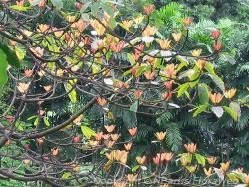Singing Forest
Showcasing 38 native tree species that originally dominated our regional landscape before urbanisation, the Singing Forest project aims to intensify the already high diversity of native bird species in the Southern Ridges which span the hills of Mount Faber Park, Telok Blangah Hill Park and Kent Ridge Park.
The native tree species were selected from four botanical families to provide a wide variety of food sources as well as shelter and nesting areas for native birds.
In the first phase are trees that include members of the mahang tree family (Euphorbiaceae) and the bean family (Leguminosae). These trees fruit soon after planting. Their fruits are small and this would attract both small and large native bird species in the short to medium term.
In the second phase are trees that include members of the wild nutmeg family (Myristicaceae) and forest mangosteens (Guttiferae). These trees produce larger fruits, which in turn attract larger birds. such as green pigeons, and hornbills. These trees need more time to grow and bear fruit.
In turn, the birds will disperse the seeds of these and other plants. Thus in the long term, the planting will help to regenerate the Southern Ridges forests.
Meanwhile, visitors to Southern Ridges will enjoy the chorus of bird song! It was reported that in a few months, NParks will start guided walks and bird-watching trips here.
Forest of Giants
Last month, NParks also launched the Forest of Giants at the Southern Ridges!
Spread across about 76 hectares, a very special collection of giant, slow growing trees are being planted. The Forest of Giants will feature more than 600 trees of 55 species. These species are native to the Southeast Asian region and many are threatened due to urbanisation or logging. Some may only be found deep within the primary forests of Southeast Asia.
Two-thirds are of species that will grow up to 40m to 80m. Among them is the Tualang (Koompassia excelsa) which can grow as tall as 80 metres, nearly as tall as a 30-storey HDB block.
 Others include trees such as Jelutong (Dyera costulata), which are native to the region's lowland forests, and some are still found in Singapore's nature reserves.
Others include trees such as Jelutong (Dyera costulata), which are native to the region's lowland forests, and some are still found in Singapore's nature reserves. These giant trees will take about 50 years to reach their full height, compared to a typical tree which takes about 20 years to reach maturity.
These giant trees will take about 50 years to reach their full height, compared to a typical tree which takes about 20 years to reach maturity.Trees are a living legacy that benefit many generations to come.
And anyone can plant a tree!
Since the start of the Garden City Fund's Plant-A-Tree programme in 2007 8,000 trees have been pledged and planted by corporations and individuals.
At the launch of the Forest Giants, National Development Minister Mah Bow Tan said "Development is important for us but at the same time we have to make every effort to conserve what we have."
More links
- Southern Ridges on the NParks website with downloadable DIY guides to various portions of the Ridges and information on cost of guided walks there.
- Other walks and events to see and learn about our forests and trees.
- Plant-A-Tree programme by the Garden City Fund.
- Media articles about the launch of the Singing Forest.
- Media articles on the launch of the Forest Giants.

No comments:
Post a Comment